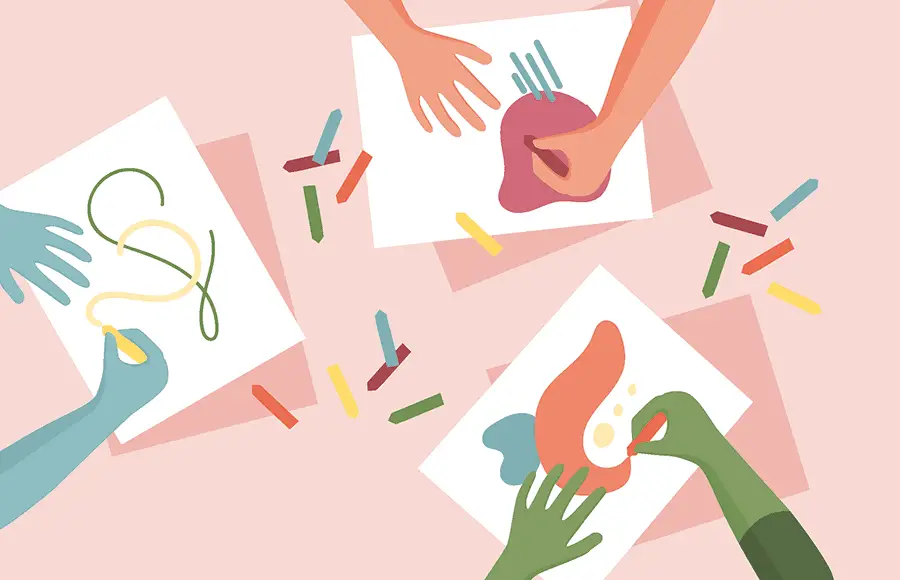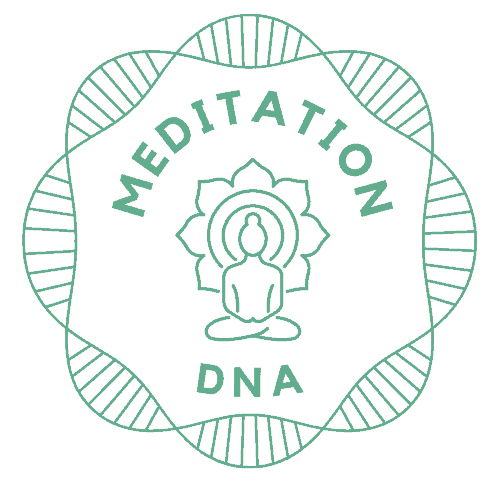
It’s a known fact that meditation enhances our focus and directs our attention to the present moment so how can we express art therapy with mindfulness?
This only makes sense as creating art or using our hands to create something (think sculpting, pottery, painting, drawing, etc.) is a mindfulness activity in itself.
We have discussed how mindfulness and mediation enhance our creative centers in a previous article…
So how exactly does art influence our mental health and how can it be used as a therapeutic practice similar to meditation?
Introducing the transformative technique of Art Therapy…
Let’s start off with understanding what Art Therapy is and what it involves.
Definition Art Therapy
What is art therapy?
Art Therapy is a form of psychotherapy that uses creative processes, such as drawing, painting, sculpting, music, dance, movement, writing, and photography, to help patients express themselves, gain insight into their inner world, and explore new ways of thinking about themselves and others.
How does art therapy work?
A person who has experienced trauma often cannot verbalize their story due to fear, shame, anger, guilt, depression, anxiety, confusion, or whatever else they experience. This is especially the case in patients that suffer from PTSD.
Art therapy helps them overcome these obstacles so that they can share their experiences with someone whom they trust enough to reveal themselves. By doing so, they gain perspective on life’s events. They become free from negative thoughts and behaviors which have resulted in suffering and unhappiness.
As humans, we all react differently to stressful situations and traumatic memories. We tend to avoid talking about painful topics because they might trigger unpleasant reactions like panic attacks, flashbacks, nightmares, crying spells, headaches, stomach aches, insomnia, substance abuse, suicide attempts, paranoia, rage, hostility, violence towards ourselves and others, eating problems, lack of motivation, withdrawal, procrastination, failure, low energy levels, loneliness, social phobia, and poor concentration.
Using art allows us to process difficult subjects without having to face them directly. It allows us to express this in a non-verbal way – many people find verbal communication difficult.
Carry on reading to explore ideas for art therapy.
Mindfulness art therapy activities
Techniques and art therapy idea can include:
- Collage
- Coloring
- Doodling and scribbling
- Drawing
- Finger painting
- Painting
- Photography
- Sculpting
- Working with clay/pottery
A career in art therapy
Art therapy as a career is possible. There are opportunities in jobs for art therapy by becoming an art therapist.
Therapists help patients express themselves and learn new ways to deal with problems through making art about their feelings and experiences. They may analyze what they’ve created and how it affects them. Through this process, patients can understand their emotions better and learn new ways to cope with their problems.
Art therapists can help look at the art created and analyze why they created it and how it makes them feel. It provides a starting point to processing trauma. People who explore their art by looking at its themes and conflicts can find out why they think, feel, and behave the way they do.
Art Therapy with adults – What Art Therapy Can Help With
Art therapy can be useful for treating a variety of mental health issues and emotional difficulties. CBT and other psychotherapy techniques are often combined with art therapy for some conditions such as:
- Aging-related issues Anxiety
- Cancer/HIV Art therapy
- Depression art therapy
- Eating disorders
- Emotional difficulties
- Family or relationship problems
- Medical conditions
- Psychological symptoms associated with other medical issues
- Post-traumatic stress disorder (PTSD)
- Psychosocial issues
- Stress
- Substance use disorder
Mindfulness-based art therapy has come to the forefront as a way of dealing with our emotional state by combining the techniques of art therapy and mindfulness.
The concept of mindfulness originated from Buddhist practice and reflects a focus on awareness of emotions, physical sensations in the body, and consciousness . When you are being mindful, you have an enhanced ability in terms of your self-awareness and capacity to reflect on your experience and daily life. (verywellmind.com)
Mindfulness-Based Art Therapy:
In this type of art therapy, patients create artwork using mindfulness principles while focusing on their emotions and bodily sensations. The therapist guides the patient during the session; however, it is not necessary to know how to draw or paint well.
For example, the therapist may ask questions like “what color would best represent the emotion you want to convey?” Or, “how could you depict your pain more accurately if you were able to see it?”.
These types of guided sessions allow clients to access emotions and memories through imagery rather than direct expression. Through repeated practice over time, people learn skills that enable them to better regulate and handle stressors and develop coping strategies when faced with challenging situations.
Mindful awareness enables one to recognize internal conflicts, resolve them, and then proceed toward healthier behavior patterns.
Read about the benefits art therapy can have for you below.
Benefit of Art Therapy:
• Provides opportunities for individuals to relax
• Allows participants to reflect upon past experiences
• Helps people understand their own mindsets
• Increases empathy between client and facilitator
• Promotes increased communication
• Encourages exploration of issues related to identity formation (identity crisis)
• Gives people tools to cope with challenges in everyday life
• Improves moods
• Makes learning easier
• Decreases resistance to change
• Facilitates positive growth and development
• Teaches patience
• Creates a feeling of security among group members
• Reduces symptoms associated with mental illness
• Enables relaxation
• Can reduce aggression
• Enhances cognitive ability
Mindfulness-Based Art Therapy for Child
Kids Art therapy has long been used with children experiencing emotional distress and/or behavioral issues.
Children could depict their imagination and the way they might be feeling in the form of drawing, creating, painting, or playing instead of speaking about it. Used with children, MBAT has been shown to improve mindfulness skills, decrease stress levels, and boost emotional well-being. It also increases emotional resilience, self-compassion, self-awareness and teaches helpful strategies to cope with emotions that will be useful later in life.
Mindfulness-based art therapy includes both traditional art-making and drama therapy. Music therapy may be included too. Art therapy uses various types of media such as painting, drawing, sculpture, music, dance, drama, poetry, film, photography, and writing to help people express their emotions, For instance, young people may watch an animated film featuring characters performing exercises such as deep breathing and visualization techniques to help them develop their ability to control their emotions.
Art therapy helps people cope with trauma and depression. While there isn’t much evidence about whether or not it works for children, it does seem to help them feel better.
In studies of adults who experienced trauma, art therapy was found to significantly reduce trauma symptoms and decrease levels of depression.
One review of the effectiveness of art therapy found that this technique helped patients undergoing medical treatment for cancer improve their quality of life and alleviate a variety of psychological symptoms.
One study found that art therapy reduced depression and increased self-esteem in older adults living in nursing homes. (verywellmind.com)
Quote about art therapy:


Colleges with Art therapy and Schools for art therapy:
- The University of New York, MA in Art Therapy
- School of the Art Institute of Chicago MA in Mental Health Counseling-Art Therapy
- Adler University, MA in Mental Health Counseling-Art Therapy
- Drexel University Art Therapy and Counseling MA
- Springfield College Art Therapy/Counseling MS
- Georgia College and State University Art Therapy Masters Program M.A.
- Southern Illinois University Edwardsville Art Therapy Counseling MA
- Florida State University MS in Art Therapy
Online degree Art Therapy:
There are a few Art therapy online degrees and courses that exist:
Misconceptions towards art therapy:
There are a few misconceptions when it comes to this type of therapeutic practice.
- Art therapy is not only for artists – anybody can take part and you do not have to know or have any specific skill in creating art of any form. Art therapists facilitate sessions based on your experience.
- Art therapy does not mean you are attending an art class
- Since it is slightly more unconventional it might not be for everyone and that is why it is always important to find what techniques and methods of therapy work for you.
- Art therapy can happen in all kinds of places and spaces and does not need a dedicated studio. These places could include – art studios, colleges, schools, universities, kindergarten schools, community centers, homeless shelters, hospitals or clinics, private offices, correctional facilities, art therapy groups.
- Art therapy for groups is also available and it does not always happen one-on-one.
“Art is a guarantee to sanity,” said Louise Bourgeois, a French-American artist who died in 2010 at the age of 98. She even went on to add, “…This is the most important thing I have said.” For Bourgeois, art — making art — was a tool for coping with overwhelming emotion. She says she remembers making small sculptures out of bread crumbs at the dinner table when she was a little girl – as a way of dealing with her dominating father. Art was more than an escape – it kept her sane.
washingtonpost.com
3 express art therapy similarities with meditation
1. Art transport us towards self-connection
Art has been used by people who suffer from mental illness to help them cope with their struggles. Emotional stability affects us mentally; enjoying emotional stability involves accepting ourselves for who we are. It is, therefore, safe to say art holds many healing properties.
Research has shown the power of meditation and the science behind it. One of the reasons it is so powerful is that it fosters acceptance. Creating art is a type of meditation, an active training of the mind that increases awareness and emphasizes acceptance of feelings and thoughts without judgment and relaxation of body and mind.
In art, just like in meditation, we create space between our often dark, fearful thoughts and connect with our truest selves by creating something beautiful. Both these practices revolve around practicing being present and detaching from our worries or thoughts.
In its natural state, creativity is an expression of our innermost feelings. It is not something we create; rather, it comes out naturally when we let go of control and surrender ourselves to the creative flow.
2. Art tunes in to the state of freedom and flow similar to meditation
Art has been used for centuries to help people access their inner selves. In general, we enter into a state of mind called “flow” when doing something enjoyable like playing music, writing poetry, painting, dancing, etc., where our attention becomes completely absorbed by whatever task we’re engaged in at the moment. This is present moment awareness.
Creativity taps into an inner state of pure awareness where there is no separation between self and others, subject and object, past and future, inside and outside.
3. Art = self-expression
Artmaking allows us to express ourselves without having to use words. Creativity is a universal language and can form deep connections in a non-verbal way.
Creative therapies such as art, music, dance, drama, etc., can help people express their feelings and emotions when they cannot say them directly. We don’t even have to understand the art piece fully in order for it to create an emotional reaction within us.
In art we find our true selves without any interference from others, without judgments or censorship. Thus, art allows us to express ourselves freely.
In conclusion, creating art is a form of deep therapy. It accesses parts of us that we might not even realize were there and allows us to work through emotions in a more indirect way. We as humans are creative beings and by channeling our inner artist we can live a more stress-free life.
Art can be our meditation.


